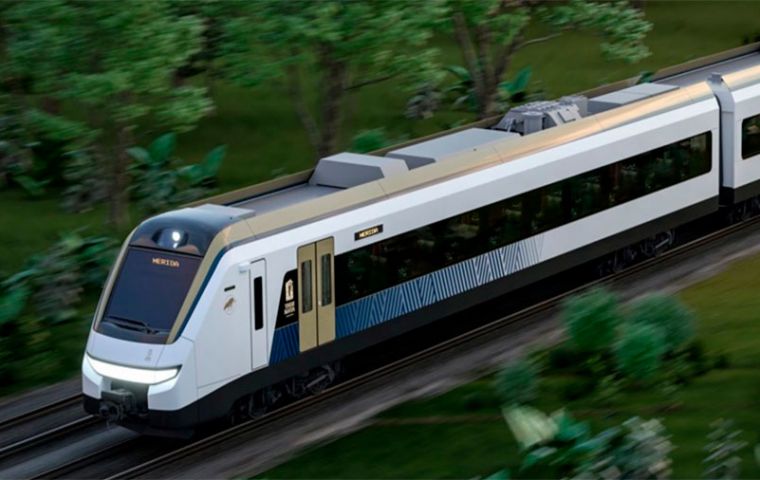MercoPress. South Atlantic News Agency
Mayan Train poses environmental threat to southern Mexico
 Most of the damage is noticeable to the naked eye between Playa del Carmen and Tulum, in Quintana Roo.
Most of the damage is noticeable to the naked eye between Playa del Carmen and Tulum, in Quintana Roo. Environmentalist groups in Mexico have raised objections to one of President Andrés Manuel López Obrador's (AMLO) most publicized works - the Mayan train - is devastating huge swathes of virgin jungles.
The railroad, which in under construction and passes through five states in the southeast of the country, has reportedly destroyed some 120 square kilometers of jungle, while 8.7 million trees and plants have been cut down. Earth-conscious associations have also warned some 6,000 cenotes (natural wells) and subway rivers are at risk.
Pedro Uc of the Assembly for the Defense of the Maya Muuch'Xiinbal Territory, pointed out that as per the original layout large areas of jungle were to be affected but when the project was changed, the damage was amplified. The plan was initially budgeted at around US $ 6 billion, but has gone up to US $ 10 billion, due to changes in the design.
The rail system will cover nearly 1,500 kilometers through the states of Chiapas, Tabasco, Campeche, Yucatan and Quintana Roo, some of which are among the poorest in the country.
Uc stressed the environmental impact generated by this project is “very serious and will not be compensated in any way.” He added AMLO's order to “urgently finish” the project despite the fact that it is “badly done” puts “the lives of many people at risk.”
NGOs have criticized AMLO's administration foir failing to submit an environmental assessment as to the possible consequences of the railroad to the area, particularly a change to the route between Cancun and Tulum, in one of the most sought-after tourist regions of the country, in the state of Quintana Roo, in a stretch of 120 kilometers, in order “not to affect the luxury hotels,” regardless of actual consequences to more than 6,000 cenotes and underground rivers.
“It is a poorly done work that involves the destruction of space. It is a very large project that is destroying a good part of the Yucatan Peninsula,” Uc said. It also “represents a risk for users,” he added. In 2021 he requested two judicial injunctions to stop the work.
An initiative which has already been endorsed online by over 63,000 people, activists claim that “the hasty construction of this project threatens the health of ecosystems and their biodiversity, the conversation of fauna, the aquifers that are fundamental for the tourist attraction and for nature.”
The Mayan Train will fragment the jungle and “will cause irreversible impacts to vegetation, soil, water and biodiversity, accelerating urbanization,” the activists went on and they also pointed out that since the final exact route is yet to be determined, these organizations are unable to gauge the exact environmental impact this work may have in the end.
It has, so far, cased deforestation and contamination of caverns, lagoons, mangroves and cenotes, which translates into the “extinction of flora and fauna,” according to these groups. Most of the damage is noticeable to the naked eye between Playa del Carmen and Tulum, in Quintana Roo.
The Mayan Train route is inhabited, among others, by species of bats, which could be “mortally damaged” by the railroad tracks and put “at risk the integrity of their home, the cave ”El Volcán de los Murciélagos” (The Bat Volcano), according to the digital site Serendipia. In the 41 municipalities across the current route, there are 94 species face similar fates, according to this website.




Top Comments
Disclaimer & comment rulesCommenting for this story is now closed.
If you have a Facebook account, become a fan and comment on our Facebook Page!